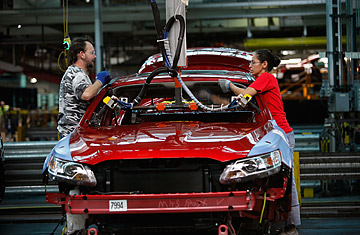
Workers install the headliner in a car on the assembly line at Ford's Chicago Assembly plant in Chicago, Illinois.
One of the by-products of the long recession in American manufacturing has been the rise of the union-sanctioned two-tier wage system, which has left some workers getting paid less than others for the same work. "It is tough when you are working Sunday [overtime] making $30 an hour, next to someone making $50 per hour, all the while knowing that you will never have an opportunity to move up to their level of pay, let alone their benefits," says Justin West, who was hired in on the second tier at a John Deere plant in East Moline, Ill.
Most workers try to avoid talking about the old wage and the new wage, but that doesn't mean they aren't thinking about it. "Unfortunately, I sense, a subtle animosity towards the old-wage workers in general," says West, that suggests "they need to retire and get out so the younger hires can move up."
Tom Adams, who just obtained a Ph.D. from Michigan State University in labor studies after spending years on a GM assembly line in Flint, Mich., contends that the two-tier system flies in the face of unifying principles outlined in the UAW's constitution. "It destroys solidarity," he says.
Of course, resentments don't just flow one way. In 2007, union members at what was then a Delphi plant in Rochester, N.Y. voted to accept contract concessions. The catch was that the 700 workers on the second tier got a raise of roughly $1 per hour, while the 300 older workers with traditional wages saw their pay cut from $28 per hour to $16.50 per hour. "It caused a lot of tension," says Lynn Giglio, who was hired in on the second tier while her husband was working under the traditional wage scale.
Despite the friction, UAW President Ron Gettelfinger defends the union's two-tier strategy. "We did what needed to be done to save our industry. Without [it] more communities would have been devastated by additional plant closures," he said during a recent speech at Indiana University.
As internal union tensions mount, another union subgroup — retirees — are also speaking up, demanding more rights. The UAW has traditionally negotiated on behalf of retirees, yet they haven't been able to vote directly on contracts. Retired union members have proposed changing the UAW constitution to give them a voice on contracts but the executive board has resisted such proposals in the past, noting that retirees don't have to bear the financial consequences of any possible strike to enforce contract demands. "There are two distinct groups of employees now," said one long-time union official, referring to active and retired members. "They have different interests."
As for active workers, the recession has slowed the shift to second-tier labor because employers first need to find new jobs for 4,000 older first-tier workers now on layoff. However, if auto sales continue to improve the shift in labor will pick up. Chrysler could begin hiring second-tier workers as soon as the fall and Ford has only a few hundred employees on layoff eligible for jobs as it ramps up production over the next few months, though it doesn't expect to hire new employees for a while yet.
Sean McAlinden, vice president at the Center of Automotive Research in Ann Arbor, Mich., believes the domestic car makers could gain a competitive edge from the second-tier wages. "I think it's possible the two-tier system could give Detroit a labor cost advantage," he says. Up until now, Asian and European carmakers haven't used two-tier system, though they have used temporary labor to hold down costs. But that could change, McAlinden says, if Detroit emerges with a clear labor-cost advantage in the next couple of years.
